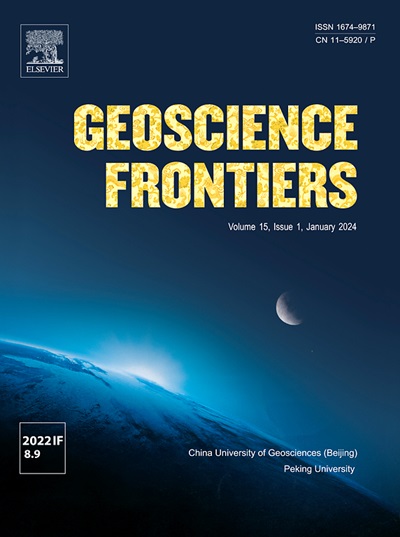Neoarchean-Paleoproterozoic metallogenesis associated with plate tectonics in early Earth: Insights from the North China Craton
IF 8.5
1区 地球科学
Q1 GEOSCIENCES, MULTIDISCIPLINARY
引用次数: 0
Abstract
Precambrian cratons are archives of several precious metallic deposits that significantly contribute to our planet’s resources and habitability and also provide key information on plate tectonics on Earth. The North China Craton (NCC) preserves important records of Neoarchean to Paleoproterozoic tectonic processes and associated episodes of metallogenic pulses that generated five major types of mineral deposits including banded iron formations (BIFs), volcanogenic massive sulfide (VMS) Cu–Pb–Zn deposits, orogenic Au deposits, magmatic sulfide Cu-Ni deposits and porphyry Cu deposits. These deposits are distributed in Neoarchean granite-greenstone belts and Paleoproterozoic orogenic belts, and show dominant mineralization ages of 2.6–2.5 Ga and two subordinate age groups of 2.7–2.6 Ga and 2.3–1.95 Ga. The Neoarchean metallogenic events generated BIFs, VMSs, Au and magmatic sulfide Cu-Ni deposits and the tectonic framework correlates with the microblock amalgamation and plate subduction possibly also aided by mantle plumes. The BIFs representing the dominant mineral deposits in Neoarchean are mainly Algoma-type with few examples of Superior-type. Meta-basaltic rocks associated with the Algoma-type BIF deposits in the granite-greenstone belts of the NCC display highly variable trace element compositions and LREE-depleted and LREE-enriched. The REE distribution patterns and high field-strength element characteristics of meta-basaltic rocks suggest the formation of BIF and VMS deposits in mid-ocean ridge, island arc and back-arc settings. The formation of VMS, Au and magmatic Cu-Ni deposits correspond to plate subduction and collision in a convergent continental margin setting during the late Neoarchean. The Paleoproterozoic deposits are represented by BIFs and porphyry Cu deposits. The Paleoproterozoic BIFs and meta-basaltic rocks correspond to magmatic-hydrothermal activities in passive continental margin or island arc settings, whereas the porphyry Cu deposits were formed in an extensional environment, corresponding to the Paleoproterozoic subduction-rifting events in the Trans-North China Orogen. The variation of δ56Fe, Ce anomalies and Y/Ho ratios in BIFs from Neoarchean to Paleoproterozoic indicate the initial increase of oxygen in late Neoarchean and the change of ambient marine environment from anoxic to oxic during the Great Oxidation Event. The multi-stage Neoarchean to Paleoproterozoic metallogenic systems of the NCC were intrinsically linked to the plate subduction along with arc-plume interaction and rifting-subduction-collision activities. The contemporaneous increasing in weathering of exposed continental crust due to plate subduction potentially controlled the atmosphere-hydrosphere oxidation state and formation of BIF deposits in the NCC.

与地球早期板块构造有关的新太古代-古元古代成矿作用:来自华北克拉通的启示
前寒武纪克拉通是几种贵重金属矿床的档案,对我们星球的资源和可居住性有重要贡献,也提供了地球板块构造的关键信息。华北克拉通(NCC)保存了新太古代至古元古代构造过程的重要记录和成矿脉冲的相关事件,这些事件形成了带状铁矿床(BIFs)、火山块状硫化物铜铅锌矿床(VMS)、造山带金矿床、岩浆硫化物铜镍矿床和斑岩型铜矿床等五大矿床类型。矿床分布于新太古代花岗岩-绿岩带和古元古代造山带,成矿年龄主要为2.6 ~ 2.5 Ga,次成矿年龄为2.7 ~ 2.6 Ga和2.3 ~ 1.95 Ga。新太古代成矿事件产生了bif、vms、Au和岩浆硫化物铜镍矿床,构造格局与微块合并和板块俯冲有关,可能也有地幔柱的辅助作用。新太古代的优势矿床以阿尔戈马型为主,优势型较少。NCC花岗岩-绿岩带中与阿尔戈马型BIF矿床相关的变质玄武岩显示出微量元素组成变化较大的特征,表现为低稀土元素贫与富。变质玄武岩的稀土元素分布模式和高场强元素特征表明,BIF和VMS矿床形成于洋中脊、岛弧和弧后环境。VMS、Au和岩浆型铜镍矿床的形成对应于新太古代晚期收敛大陆边缘环境下的板块俯冲碰撞作用。古元古代以斑岩型铜矿床和斑岩型铜矿床为代表。古元古代的斑岩和变质玄武岩对应于被动大陆边缘或岛弧背景下的岩浆-热液活动,而斑岩型铜矿则形成于伸展环境,对应于跨华北造山带古元古代的俯冲-裂陷活动。从新太古代到古元古代的δ56Fe、Ce异常和Y/Ho比值的变化表明新太古代晚期氧初始增加,大氧化事件期间海洋环境由缺氧向缺氧转变。新太古代至古元古代的多期成矿系统与板块俯冲、弧-羽相互作用和裂陷-俯冲-碰撞活动有着内在联系。与此同时,由于板块俯冲作用,暴露的大陆地壳的风化作用增强,可能控制了北陆盆地大气-水圈氧化状态和BIF矿床的形成。
本文章由计算机程序翻译,如有差异,请以英文原文为准。
求助全文
约1分钟内获得全文
求助全文
来源期刊

Geoscience frontiers
Earth and Planetary Sciences-General Earth and Planetary Sciences
CiteScore
17.80
自引率
3.40%
发文量
147
审稿时长
35 days
期刊介绍:
Geoscience Frontiers (GSF) is the Journal of China University of Geosciences (Beijing) and Peking University. It publishes peer-reviewed research articles and reviews in interdisciplinary fields of Earth and Planetary Sciences. GSF covers various research areas including petrology and geochemistry, lithospheric architecture and mantle dynamics, global tectonics, economic geology and fuel exploration, geophysics, stratigraphy and paleontology, environmental and engineering geology, astrogeology, and the nexus of resources-energy-emissions-climate under Sustainable Development Goals. The journal aims to bridge innovative, provocative, and challenging concepts and models in these fields, providing insights on correlations and evolution.
 求助内容:
求助内容: 应助结果提醒方式:
应助结果提醒方式:


